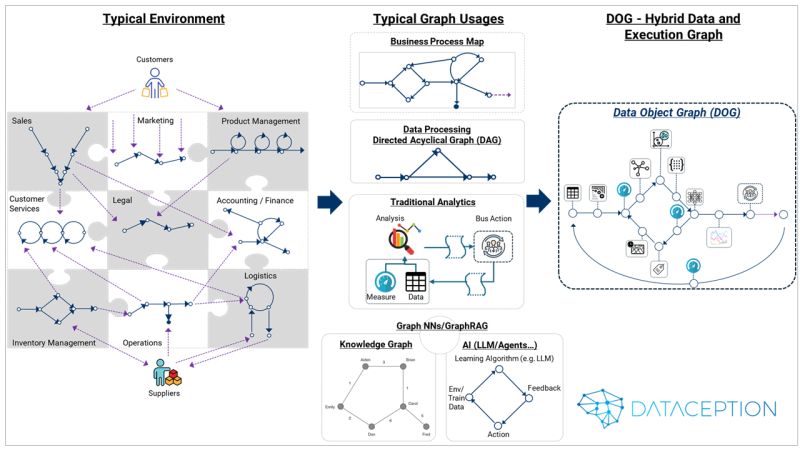Why Directed Acyclic Graphs (DAGs) Are No Longer Enough
For years, Directed Acyclic Graphs (DAGs) have been the backbone of data processing and orchestration. Tools like Apache Airflow, Spark, and Prefect have relied on DAGs to structure workflows, ensuring that tasks execute in a linear, dependency-driven manner. But here’s the challenge:
🔹 Business processes are not acyclic—they have loops, feedback mechanisms, and iterative decision-making.
🔹 AI-driven workflows thrive on cycles—reinforcement learning, agent-based architectures, GraphRAG, and Graph Neural Networks (GNNs) all involve recursive logic and iterative improvements.
🔹 Modern data is complex—structured tables don’t cut it anymore; we deal with embeddings, images, multi-modal data, and real-time decision-making models.
AI doesn’t work in neat, straight lines. It learns, adapts, iterates, and interacts with evolving data streams. DAGs struggle to model this reality.
Introducing Data Object Graphs (DOGs): The Future of AI-Driven Workflows
At Dataception Ltd, we’ve been pioneering Data Object Graphs (DOGs)—a revolutionary hybrid approach that combines data and execution into a single, queryable, adaptable, traversable graph. DOGs bridge the gap between data pipelines, AI workflows, and business processes in a way DAGs never could.
🔹 DOG nodes are objects, not just data points—they contain both state (data) and methods (executable functions).
🔹 DOGs enable feedback loops—critical for AI, risk models, simulations, and iterative decision-making.
🔹 DOGs seamlessly integrate data with execution—no more forcing AI into rigid DAG structures that don’t align with real-world complexity.
Example: In a business process like fraud detection or customer support automation, a DOG can:
✅ Store customer history and risk scores as data nodes
✅ Trigger AI-based decision models as executable nodes
✅ Loop back when new evidence emerges, continuously refining decisions
Why DOGs Are the Missing Piece in Data Mesh and AI Architectures
Most modern architectures, from Data Mesh to Data Fabric, focus on decentralized, domain-driven data management. But they still rely on:
❌ Relational models that struggle with unstructured, multi-modal data
❌ Pipeline-based execution that doesn’t accommodate AI-driven feedback loops
❌ Disconnected data & execution layers that slow down real-time decision-making
DOGs unify these elements into a single, intelligent execution graph.
🔥 Think of it as Object-Oriented Programming (OOP) applied to AI and Data Processing—where objects (DOG nodes) aren’t just storage units but active decision-making entities.
DOGs in Action: A Glimpse into the Future
At Dataception Ltd, we’ve been developing DOG-powered solutions for years. We believe this approach will:
🚀 Revolutionize AI orchestration—enabling self-optimizing, adaptive AI workflows
🚀 Enable true AI-native business processes—by modeling real-world complexity, not just data movement
🚀 Redefine rapid application development (RAD)—creating a visual, no-code/low-code way to map AI-driven workflows that mirror actual business processes
This is the next big thing in AI and data architectures, and we’re just getting started.
What’s Next? Stay Tuned
We’ll be sharing deep dives, technical breakdowns, and real-world applications of DOGs in the coming weeks.
This isn’t just another buzzword. It’s the future of AI-driven business workflows. If you want to be part of this transformation, reach out to us at Dataception Ltd and let’s discuss how DOGs can power your AI and analytics strategy.

💡 Watch this space. Big announcements coming soon! 🚀

